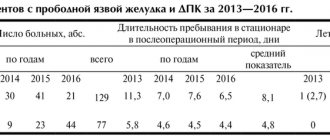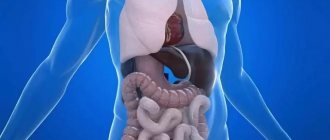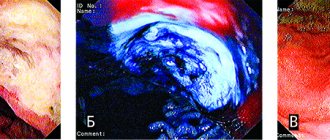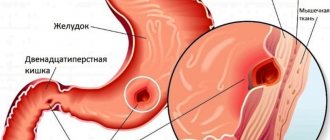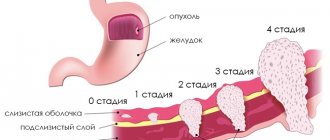What does an ultrasound of the stomach show?
The content of the article
The anatomical location, contents and presence of a gas bubble in the stomach greatly complicates visualization of the organ. However, ultrasound is a rational diagnostic method, since it allows one to evaluate the terminal and output sections, and lesions are most often concentrated in them.
On an ultrasound of the stomach you can clearly see:
- minor and major curvature;
- part of the body of the stomach;
- gatekeeper cave;
- gatekeeper channel;
- pyloric sphincter - the area of transition into the duodenum;
- part of the duodenum.
During the procedure, the doctor evaluates the size of the organ, its shape and size, location, wall thickness, echostructure, motor function, as well as the presence of deformations and foreign objects.
Ultrasound of the stomach is often included in ultrasound of the abdominal cavity. In this case, the doctor sees other organs of the gastrointestinal tract.
What stomach diseases can be detected by ultrasound?
Sonography of the stomach allows you to identify many diseases at an early stage of development:
- diaphragmatic hernia;
- gastritis, peptic ulcer;
- gastroesophageal reflux;
- swelling of the walls;
- malignant lymphoma;
- varicose veins of the stomach;
- diffuse neoplastic wall thickening;
- malignant and benign neoplasms;
- congenital and acquired pyloric stenosis - narrowing of the pyloric outlet;
- carcinoma;
- lack of delimitation of the wall into normal layers;
- aberrant tumor vessels;
- cystic formations;
- inflammation of the internal cavity of the organ;
- mesenchymal tumors.
Causes
Gastric cancer is a malignant tumor with uncontrolled growth that develops from the cells of the mucous membrane of the organ. Separately, lymphoma is distinguished - a tumor that is formed from lymphatic tissue (there is a lot of it between the layers of the wall). However, during the initial diagnosis before biopsy, they cannot be separated, since symptoms and signs often overlap.
Among the causes of oncological pathology it is necessary to highlight:
- infection with Helicobacter pylori infection;
- chronic inflammatory and erosive processes (gastritis and peptic ulcer);
- long-term presence of Crohn's disease;
- genetic predisposition;
- decreased reactivity of the immune system;
- smoking and alcohol abuse;
- irregular meals;
- exposure to ionizing radiation and environmental pollution.
Indications
Timely ultrasound examination will help maintain health and avoid various serious consequences. Ultrasound of the stomach is indicated not only for certain obvious pathologies, but also when a number of alarming symptoms appear:
- prolonged heartburn, nausea, vomiting, frequent belching;
- frequent pain of various types in the gastrointestinal tract;
- disturbance of the digestive process, loss of appetite, bloating;
- gastritis, ulcer;
- congenital anomalies of organ development;
- suspicion of cancer;
- polyps;
- pyloric stenosis, intestinal obstruction;
- suspicion of embryonic anomalies;
- severe discomfort in the abdominal area in a pregnant woman.
There are a number of separate indications for performing ultrasound of the stomach in children:
- frequent bronchitis;
- asthma;
- causeless increase in temperature;
- dry cough;
- excessive regurgitation in infants;
- abdominal pain;
- diarrhea, constipation, change in stool character;
- causeless nausea and vomiting.
Even healthy people are recommended to undergo an ultrasound of the stomach for preventive purposes. Moreover, all types of ultrasound can be done without a referral from a gastroenterologist or therapist, on your own initiative.
Classification
A classification of stomach cancer is often used depending on the degree of progression and spread of the cancer process:
- Stage 0 – the process affects only the mucous membrane;
- Stage 1 – growth of pathologically altered cells into the submucosal layer is observed, distant foci cannot be detected;
- Stage 2 - the process spreads to the muscular and serous layers of the wall, several foci were also found in the nearest lymph nodes;
- Stage 3 – the tumor actively metastasizes through the regional lymphatic system (more than 3 confirmed foci), but without involving other organs;
- Stage 4 - when performing an ultrasound, CT or MRI, it was possible to find foci of the process in other organs (liver, spine, brain, spleen, kidneys or others).
Stages of development of stomach cancer
How to prepare for the procedure
Compliance with all recommendations regarding preparation for an ultrasound examination of the stomach will give the most accurate and high-quality result. Preparation is carried out in several stages and consists of the following:
- 2-3 days before the procedure
. A diet aimed at reducing gas formation in the stomach and intestines is required. To do this, avoid drinking carbonated drinks, fresh vegetables and fruits, herbs, legumes, sweets, dairy and yeast products, rye bread, fresh juice, black tea and coffee. Also avoid alcohol and smoking. It is recommended to form your diet from boiled meat, fish, cottage cheese, soft-boiled eggs and porridge cooked in water. If necessary, you need to take enzymes that improve the digestion process (mezim, festal, etc.). A day before the procedure, it is necessary to cleanse the body with the help of sorbents (activated carbon, smecta, etc.), and for people suffering from stool disorders, with the help of laxatives. - On the eve of the procedure
. The study is carried out strictly on an empty stomach. As a rule, it is prescribed in the morning, so the last meal should be a light dinner 10-12 hours before the ultrasound. For children, fasting should last 6-8 hours, and for infants 3-3.5 hours, while their stomach is examined immediately after feeding. - Before the procedure
. Skip breakfast and drinks. It is not recommended to even brush your teeth, as there is a possibility of toothpaste getting into your stomach.
Clinical picture
The symptoms of the disease also differ greatly depending on the stage of the process. But the problem with this oncological pathology is that the clinical picture, even in stage 3, may not differ from gastritis or peptic ulcer. In patients with first detected stomach cancer, the following complaints are most common:
- periodic pain of varying intensity in the upper abdomen (on an “empty” stomach, or after eating);
- feeling of abdominal discomfort or fullness after a small snack
- nausea;
- a sharp change in diet, the appearance of aversion to certain types of dishes;
- decreased appetite and decreased body weight (even with an unchanged diet);
- black feces;
- belching with an unpleasant odor.
Important If you have the symptoms listed above, you should immediately seek qualified medical help.
How is an ultrasound of the stomach performed?
Diagnosis of the stomach using ultrasound is carried out transabdominally - through the abdominal wall using an external sensor. The patient lies on the couch with his back, on his side, or takes a semi-sitting position and exposes his stomach. The doctor applies a special gel to the epigastric area to improve the passage of ultrasound waves, and then scans, slowly moving the device over the area being examined.
Ultrasound of the stomach is carried out in 3 stages:
- 15 minutes before the examination, the patient needs to drink 1 liter of non-carbonated liquid (for children - 0.5 liters). This helps straighten the stomach and allows you to diagnose all possible pathological changes.
- The patient again needs to drink a small amount of liquid so that the doctor can diagnose the stomach filled with it by examining changes in the internal organs.
- After 20 minutes, the doctor conducts a second examination to determine the rate of gastric emptying and the motor function of the organ.
In some cases, for better visualization, the doctor may use a contrast agent, for example, Ekhovist-200, diluted with 0.5 liters of carbonated water.
Interpretation of ultrasound of the stomach: normal parameters of the organ
A qualified specialist, knowing the normal indicators, can simply determine pathological changes in the stomach. Normally, sections of an organ have a round or oval shape - in the form of a ring with an echo-positive central part and an echo-negative rim. The walls of the stomach are uniform and consist of 5 layers. The removal of a glass of liquid from the stomach occurs in approximately 20 minutes, and the primary withdrawal of liquid is normally about 3 minutes.
Normal values for the thickness of parts of the stomach
| Stomach in the pyloric region | up to 8 mm |
| Stomach in the proximal zone | up to 6 mm |
| Muscle layer | 2 – 2.5 mm |
| Slime layer | up to 1.5 mm |
| Submucosa | up to 3 mm |
| Lamina mucosa | up to 1 mm |
Normal echogenicity values
| Outer serous membrane | high |
| Muscle layer | low |
| Slime layer | high |
| Submucosa | average |
| Lamina mucosa | low |
| Stomach wall | varying degrees of echogenicity of the layers |
Interpretation of pathological indicators visible on ultrasound
| Pathology | Signs on ultrasound |
| Impaired gastric emptying | maximum distension of the stomach with liquid; lack of peristalsis (not always); internal echostructure may vary from anechoic to hyperechoic |
| Swelling of the wall | the thickness of the stomach wall exceeds 7 mm; homogeneous wall structure; hypoechogenicity, uniform thickening |
| Diffuse neoplastic wall thickening | the walls of the stomach are hard, inelastic, with low echogenicity; boundaries between layers are not detected; there are no organ contractions |
| Aberrant tumor vessels | a thickened wall with low echogenicity is detected due to the penetration and accumulation of tumor particles in it |
| Lack of differentiation of the wall into normal layers | the lumen in the stomach is significantly narrowed due to obliteration |
| Congenital hypertrophic pyloric stenosis | thickening of the pyloric muscle ring; slow removal of contents from the stomach; increasing organ mobility and antiperistalsis |
| Acquired pyloric stenosis | frigidity of the pyloric wall; anechoic structure, homogeneous pinpoint echo structure, or coarse internal echoes |
| Varicose veins of the stomach | the outer wall of the stomach is anechoic or cystic thickened in some areas; blood flow from the liver and portal-systemic blood flow were identified |
| Peptic ulcer | the stomach wall is thickened; crater-shaped depressions are visible on the inner surface |
| Benign tumor | formation of a round shape; has smooth edges and low echogenicity; no metastases |
| Malignant tumor | the wall of the stomach is thickened unevenly (round or lobed); the gastric outlet is narrowed; the layers of the stomach are blurred, the contours are uneven |
| Carcinoma | polypoid: lobular formation; circular: a round or oval-shaped formation with an echogenic center, inside of which there is air and mucus. Possible detection of metastases |
| Malignant lymphoma | appears similar to diffuse lymphoma or carcinoma |
| Mesenchymal tumor | benign: no more than 6 cm, vessels are not identified; malignant: more than 6 cm, tumor vessels, possible metastases |
| Cystic formations | formations of 2 layers: echogenic internal mucous and hypoechoic muscular external |
Examination of the stomach with abdominal ultrasound
Ultrasound examination of the abdominal organs
is a modern non-invasive diagnostic procedure that is absolutely safe for the patient’s body, but has a high level of information content.
This research option is often chosen by the doctor as the primary one, since it is the most accessible, has minimal training requirements, and can be carried out urgently. Also, the wide popularity of abdominal ultrasound
is ensured by
the price
, which, unlike many techniques, is low.
When is an abdominal ultrasound prescribed and what can the doctor see?
This method, in addition to the stomach, allows you to visualize many vital organs, therefore it has a wide range of indications. A general practitioner, gynecologist, urologist, nephrologist, gastroenterologist and surgeon can refer a patient for this procedure. The main indication for ultrasound diagnostics is pain of any kind in the abdominal area. There are no contraindications for diagnostics.
Complaints, the appearance of which requires an urgent ultrasound of the abdominal cavity:
- severe abdominal pain;
- feeling of heaviness in the area of the right hypochondrium;
- bitter taste in the mouth;
- aversion to fatty foods;
- yellowing of the tongue;
- detection of a tumor or other neoplasm in the peritoneum.
Ultrasound easily visualizes internal organs, and hollow organs can also be seen if they are filled with fluid. The main obstacles to a quality examination are air and fat - these features are important to consider when preparing for the procedure.
- Liver
. Ultrasound allows you to determine focal changes in liver tissue, such as adenomas, cancer, cysts. In addition, diseases such as hepatitis or cirrhosis can be seen using ultrasound. - Gallbladder and its ducts
. Ultrasound clearly identifies the following deviations from the norm: defects associated with the abnormal structure of the gallbladder (kinks, constrictions); chronic and acute cholecystitis; disturbances in the functioning of the bile ducts; cholelithiasis; polyps; tumors, both benign and malignant. - Pancreas
. Ultrasound diagnostics can reveal: acute, chronic pancreatitis; structural anomalies; tissue changes caused by diabetes; cysts, cancer and other neoplasms. - Spleen
. An organ that is difficult to diagnose, and therefore the doctor will ask the patient to take a certain position. Ultrasound allows you to identify malformations, heart attacks, mechanical damage, tumors and estimate the size of the organ. - Stomach.
In addition, the study covers organs such as the bladder, prostate gland in men and uterus in women. Abdominal ultrasound can visualize the retroperitoneum and kidneys.
How is an abdominal ultrasound performed?
The procedure is simple and painless for the patient and usually takes about half an hour. It is important to pay attention to the need to prepare for an ultrasound, which consists of completely emptying the intestines of gas, which is achieved by following a diet.
The technique involves examining the patient in the “lying on his back” position; sometimes it is necessary to turn on his side and hold his breath. If the patient has deviations in the position of the organs, then the examination is carried out in the “sitting/standing” position.
During an ultrasound, the doctor can evaluate the dimensions, position, shape, density of the structure of organs and the thickness of their walls, the ability of ducts and vessels to pass physiological fluids (bile, secretions, blood, urine), the presence of stones, and the condition of bile. Based on the results of the examination, the result is given in the form of photographs and their interpretation.
Possibilities of the technique
Ultrasound examination is prescribed for almost all patients with suspected benign or malignant disease in the stomach . High-frequency waves pass well through human tissue and are partially reflected from them (depending on the density indicator). They are then captured by a sensor located on the front wall of the abdomen, processed by a computer and displayed as an image on the screen.
Ultrasound is a routine test if there are symptoms of dyspepsia, decreased appetite or pain in the upper abdomen. In addition to the stomach, the condition of the pancreas, liver, gallbladder, spleen, lymph nodes and large vessels of the abdominal cavity is examined.
With high-quality preparation of the patient, ultrasound allows one to clearly visualize the walls of the antrum and body of the stomach . The bottom of the organ in most patients is poorly visible due to the presence of gases in it (even a small amount). If the study is carried out by an experienced specialist, he can also approximately estimate the volume of gastric juice that is in the cavity.
Alternative studies: how best to examine the stomach
Ultrasound examination does not replace endoscopy and x-ray examination; to some extent it is even inferior in terms of information content, but at the same time it has many advantages compared to them:
- high information content of the study;
- speed of the procedure;
- absolute safety – has no complications and does not harm the body;
- painlessness and lack of discomfort during the procedure;
- visualization of the state of the organ in real time, the result is visible immediately;
- the ability to see even small structures;
- allows you to study the functions of the organ and use duplex scanning to identify reflux and blood supply to the stomach wall;
- the possibility of conducting research even for infants and pregnant women;
- X-rays visualize only one projection of the organ, which is why some pathologies can be overlooked;
- during endoscopy there is a risk of infection if the endoscope is not sterilized sufficiently;
- X-rays and endoscopy do not study the entire thickness of the stomach wall and deep layers.
A significant disadvantage of gastric ultrasound is the inability to take biopsy material and physiological fluids. This can only be done by endoscopy.
